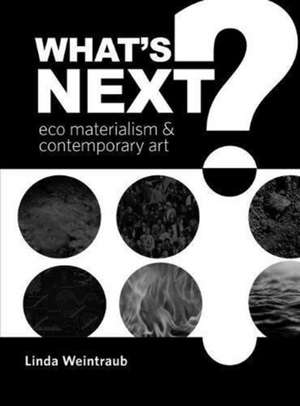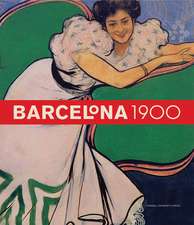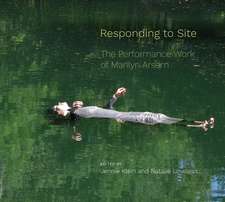What's Next?: Eco Materialism and Contemporary Art
Autor Linda Weintrauben Limba Engleză Paperback – 19 noi 2018
By paying tribute to matter, materiality, and materialization, the examples of contemporary art assembled in What’s Next? Eco Materialism and Contemporary Art challenge the social, cultural, and ethical norms that prevailed in the twentieth century. This significant frontier of contemporary culture is identified as ‘Eco Materialism’ because it affirms the emergent philosophy of Neo Materialism and attends to the pragmatic urgency of environmentalism.
In this highly original book, Linda Weintraub surveys the work of forty international artists who present materiality as a strategy to convert society’s environmental neglect into responsible stewardship. These bold art initiatives, enriched by their associations with philosophy, ecology, and cultural critique, bear the hallmark of a significant new art movement. This accessible text, augmented with visuals, charts, and questionnaires, invites students and a wider readership to engage in this timely arena of contemporary art.
In this highly original book, Linda Weintraub surveys the work of forty international artists who present materiality as a strategy to convert society’s environmental neglect into responsible stewardship. These bold art initiatives, enriched by their associations with philosophy, ecology, and cultural critique, bear the hallmark of a significant new art movement. This accessible text, augmented with visuals, charts, and questionnaires, invites students and a wider readership to engage in this timely arena of contemporary art.
Preț: 260.32 lei
Nou
Puncte Express: 390
Preț estimativ în valută:
49.82€ • 51.88$ • 42.10£
49.82€ • 51.88$ • 42.10£
Carte disponibilă
Livrare economică 18 februarie-04 martie
Livrare express 01-07 februarie pentru 47.84 lei
Preluare comenzi: 021 569.72.76
Specificații
ISBN-13: 9781783209408
ISBN-10: 1783209402
Pagini: 338
Ilustrații: 100 halftones, 10 line drawings
Dimensiuni: 178 x 229 x 33 mm
Greutate: 0.86 kg
Editura: Intellect Ltd
Colecția Intellect Ltd
ISBN-10: 1783209402
Pagini: 338
Ilustrații: 100 halftones, 10 line drawings
Dimensiuni: 178 x 229 x 33 mm
Greutate: 0.86 kg
Editura: Intellect Ltd
Colecția Intellect Ltd
Notă biografică
Linda Weintraub is a curator, educator, and artist. She is the author of many books, including In the Making: Creative Options for Contemporary Artists, To Life! Eco Art in Pursuit of a Sustainable Planet, and Art on the Edge and Over: Searching for Art’s Meaning in Contemporary Society, 1970s-1990s, as well as the innovative textbook series entitled Avant-Guardians: Textlets in Art and Ecology. She previously served as director of the Edith C. Blum Art Institute and currently teaches in the Nomad 9 MFA program at the University of Hartford's Hartford Art School.
Cuprins
Table of Contents
Introduction
Artist Index
ECO MATERIAL ALLURES & REPULSIONS
Secretions
Fingernails: Tim Hawkinson
Blood: Marc Quinn
Placentas: Gu Wenda
Sweat: Caitlin Pautler Albritton
Tears: Rose-Lynn Fisher
Ear Wax: Amanda Cotton
Breast Milk: Jess Dobkin
Fat: Sun Yuan and Peng Yu
Spit: Spurse
Hair: Germaine Koh
Feces: Terence Koh
Corpse: Maurizio Montalti
ARCHETYPES OF MATERIAL USE & DISUSE
Dirt
Pet Archetype: Amy M. Youngs
Sacred Archetype: Walter De Maria
Hazard Archetype: Hilda Hellström
Specimen Archetype: Alexandra Regan Toland
Resource Archetype: Jon Cohrs
Aesthetic Archetype: Laura Parker
Merchandise Archetype: Joe Scanlan
ECO MATERIAL OPERATIVES
People
Do-It-Without-People: James Bridle
Do-It-Yourself: Thomas Thwaites
Do-It-As-Community: Mary Mattingly
Do-It-As-Troop: Francis Alÿs
Do-It-With-Site: Rachael Mellors
ECO MATERIAL TOOLS
Fire
Fire Burns: Bruce Davies
Fire Melts Metals: Futurefarmers
Fire Sinters: Markus Kayser
Fire Cooks: Spurse
ECO MATERIAL CREATIVITY
Water
Water Condenses: Simparch
Water Dissolves: Dove Bradshaw
Water Forms Freshwater Biomes: Pierre Huyghe
Water Provides Marine Habitats: Jason deCaires Taylor
Water Inspires Reverence: Red Earth
ECO MATERIAL TECHNOLOGY
Electronics
E-Energy Consumption: Gebhard Sengmüller
E-Omnipresence: Germaine Koh
E-Waste: Raphael Perret
E-Systems: SEAD/Angelo Vermeulen
E-Memory: Alice Anderson
E-Prayer: Kal Spelletich
WHAT’S NEXT?
Option 1: Desperation: Chim↑Pom
Option 2: Relocation: Zbigniew Oksiuta
Option 3: Recuperation: Natalie Jeremijenko
Introduction
Artist Index
ECO MATERIAL ALLURES & REPULSIONS
Secretions
Fingernails: Tim Hawkinson
Blood: Marc Quinn
Placentas: Gu Wenda
Sweat: Caitlin Pautler Albritton
Tears: Rose-Lynn Fisher
Ear Wax: Amanda Cotton
Breast Milk: Jess Dobkin
Fat: Sun Yuan and Peng Yu
Spit: Spurse
Hair: Germaine Koh
Feces: Terence Koh
Corpse: Maurizio Montalti
ARCHETYPES OF MATERIAL USE & DISUSE
Dirt
Pet Archetype: Amy M. Youngs
Sacred Archetype: Walter De Maria
Hazard Archetype: Hilda Hellström
Specimen Archetype: Alexandra Regan Toland
Resource Archetype: Jon Cohrs
Aesthetic Archetype: Laura Parker
Merchandise Archetype: Joe Scanlan
ECO MATERIAL OPERATIVES
People
Do-It-Without-People: James Bridle
Do-It-Yourself: Thomas Thwaites
Do-It-As-Community: Mary Mattingly
Do-It-As-Troop: Francis Alÿs
Do-It-With-Site: Rachael Mellors
ECO MATERIAL TOOLS
Fire
Fire Burns: Bruce Davies
Fire Melts Metals: Futurefarmers
Fire Sinters: Markus Kayser
Fire Cooks: Spurse
ECO MATERIAL CREATIVITY
Water
Water Condenses: Simparch
Water Dissolves: Dove Bradshaw
Water Forms Freshwater Biomes: Pierre Huyghe
Water Provides Marine Habitats: Jason deCaires Taylor
Water Inspires Reverence: Red Earth
ECO MATERIAL TECHNOLOGY
Electronics
E-Energy Consumption: Gebhard Sengmüller
E-Omnipresence: Germaine Koh
E-Waste: Raphael Perret
E-Systems: SEAD/Angelo Vermeulen
E-Memory: Alice Anderson
E-Prayer: Kal Spelletich
WHAT’S NEXT?
Option 1: Desperation: Chim↑Pom
Option 2: Relocation: Zbigniew Oksiuta
Option 3: Recuperation: Natalie Jeremijenko
Recenzii
"Synthesizes complex theories from philosophy, ecology and art history in a meaningful way. . . . Weintraub’s handbook represents an inspirational, yet pragmatic toolkit for artists of all ages. It gives upcoming Gen Z/Millennial artists provocations to make informed decisions about their life choices and methodologies, but it also proffers food for thought for midcareer and established ones. It should be on the reading lists of all art and design courses now that, in the United Kingdom at least, sustainability and ethics are (finally) becoming key learning outcomes."
"A timely contribution, both to the burgeoning philosophical movement of new materialism, and to a renewed consideration of materiality in contemporary art-making practices, which since the 1960s have increasingly withdrawn from the material conventions of traditional media. What results from Weintraub’s efforts is a wide-ranging and fascinating . . . exploration of future-oriented artists experimenting at the vital intersections of philosophy, environmentalism, and art. . . . Each chapter can also be purchased individually as a 'textlet,' allowing teachers greater flexibility for how they assign and integrate the material in their syllabi. The book thus not only means to teach us about contemporary art and theory; through the conscientious design of its form, it also teaches us something about the material realities of publishing today. . . . The sheer range of artists and eco material practices that Weintraub has assembled in What’s Next? is astonishing, and alone makes the volume a valuable addition to art and environmental humanities collections."
"Environmental responsibility, innovation, and the re-discovery of the ‘wonder’ of life are key to What’s Next?. Linda’s passion speaks with clarity and directness about the environmental disregard of Consumer Materialism, and about an emerging philosophy New Materialism which she explains has a conscious relationship with all forms of matter, whether an acorn or pencil. New Materialism seeks for humans to regain a sensory and bodily relationship with the physicality of the planet connecting with its inherent materials and processes. Linda grounds the movement of Eco Materialism in these principles within the context of ecology and environmentalism, demonstrating it through the creative responses of the artists.
I have been working alone, isolated from other artists and I have felt rather alien to the ‘art world’. I was drawn to work with the earth but unaware I was part of a movement, I found my ways of working intuitively, tending the olive grove, making on the shoreline at sunrise, creativity embedded in life. I feel connection with the work of other artists in the book, particularly those with sensory and physical relationships with the raw materials of the earth. I resonate with the first chapter’s appreciation and inquiry into materials generated with our bodies, saliva is part of my clay sculptures. It is wonderful how through the chapters of the book Linda brings together our common reference point, taking us on a journey of creative and immersive explorations of the material environment of the planet. Her words beat an urgent call for change."
I have been working alone, isolated from other artists and I have felt rather alien to the ‘art world’. I was drawn to work with the earth but unaware I was part of a movement, I found my ways of working intuitively, tending the olive grove, making on the shoreline at sunrise, creativity embedded in life. I feel connection with the work of other artists in the book, particularly those with sensory and physical relationships with the raw materials of the earth. I resonate with the first chapter’s appreciation and inquiry into materials generated with our bodies, saliva is part of my clay sculptures. It is wonderful how through the chapters of the book Linda brings together our common reference point, taking us on a journey of creative and immersive explorations of the material environment of the planet. Her words beat an urgent call for change."
"I just finished What's Next and wanted to [say] how much I loved the book. I am so impressed with [Weintraub’s] deep and extensive scholarship, and how [the author is] able to interweave scientific, poetic, and aesthetic strands into a fabric of thought that is clear and beautiful. The book is a real treasure and resource, which asks necessary questions and frames a way forward at a time of crisis."






